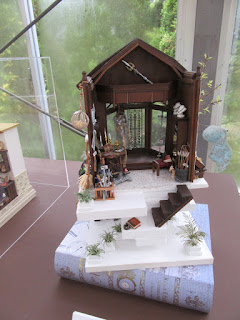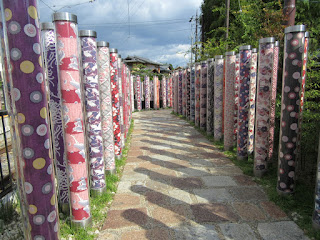Today we are going to go out and try our best with our too-short stepladder to arrange some outdoor lights in our front trees. We managed one tree last year and it looked nice so we are going to go for two this year. DS isn't coming home until quite close to Christmas this year, so we can put the tree and decorations up when we choose. Perhaps next weekend.
I spent a lot of my day off working on dollshouse stuff and I am going to try to keep that up. This week I was working on filling window boxes and hanging baskets for my shed project and to finish off the Victorian gazebo porch. I also started work on the base for the shed, riffing off some tips published by Bea Broadwood of Petite Properties in an article about creating 1:48 bases published in Dollshouse and Miniature Scene magazine. After choosing some accessories then drawing around the base of the shed, I filled the terrain in with Tetrion filler and left it to dry. It doesn't look like much yet.
The windowboxes I built myself out of lolly sticks and the hanging baskets are re-purposed bottle caps. I filled them with paperclay then 'planted' them with various bits of greenery. The wires sticking out everywhere will be the hanging basket supports. I managed to stab myself on one of the sharp wire ends and it wouldn't stop bleeding so consequently there are some interesting 'rust' stains on several baskets.
Saturday I was back at the quilting shop for a sewing day. I had prepared the rest of the pieces of the appliqued houses tea cosy and finished the quilting on it, so I was able to assemble it first thing in the morning.
I spent the rest of the morning cutting out the numerous pieces required for the honeycomb basket pattern that I bought at the Makit fair in St Ives. There are seven pockets that all require outside fabric, inside liners, bases and base liners and Bosal stiffening pieces, so it took a while. But it's all cut out now ready to start sewing.
In the afternoon I was chain piecing half square triangles for the saw tooth border of my indigo bear's paw quilt. I was annoyed to find that I was several squares short because I thought I had made enough. I couldn't face making any more right then so I started to put away my sewing machine. Guess what I found when I shifted the sewing machine? Yes, a little pile of the remaining squares hiding under the machine. So I was able to complete four strips of sawtooth. I finished off the day by stitching a very little on my Hawaiian applique quilt.
While we were watching Gilmore Girls, I was working on my Gilmore Girls Mystery Cowl, a mystery knit along organised on Ravelry. Clue 2 is really long so I am still stuck on that one, but clues 3 and 4 are already published. I can't look because I don't want to spoil the surprise. This is what I've got so far.
I was clearing out some of my sewing room yesterday and came across the Christmas panel I bought a while ago so I am considering whether I want to try to make that up in time to use as a table runner or wall hanging this year. My son was making me laugh on the telephone as he was grumbling about having to pay up for a deposit for a Christmas meal with his office team, his first experience of the non-optional social convention of office Christmas do's. We only have a small round of those this year: I'm going to DH's modelling club christmas meal and he is coming to my dollshouse club's turkey dinner at the pub. Then we both have separate office christmas meals as well. Something to look forward to, plus some holiday coming up.



































































